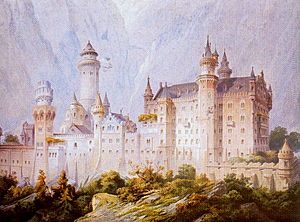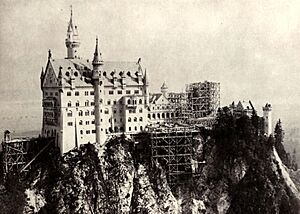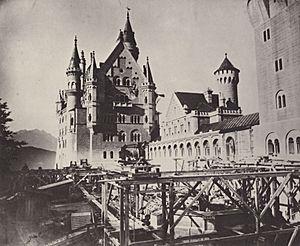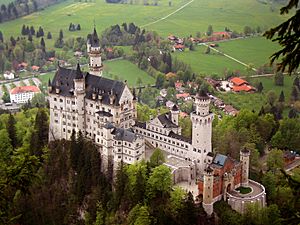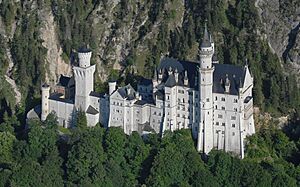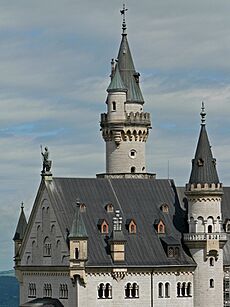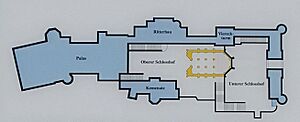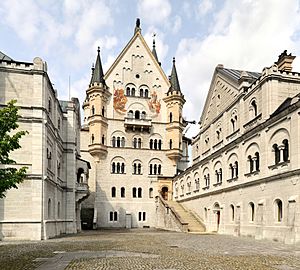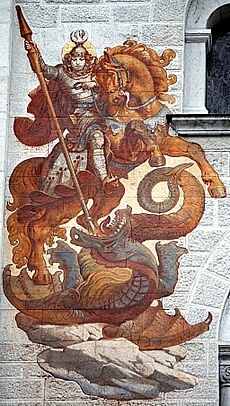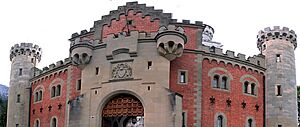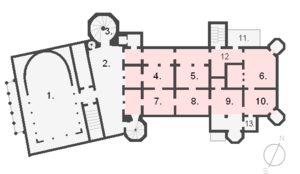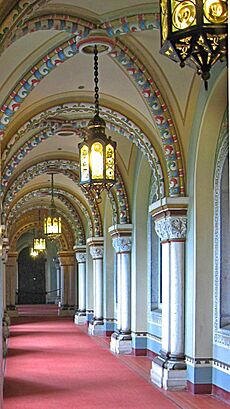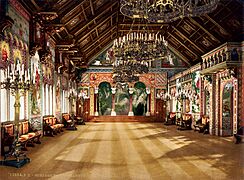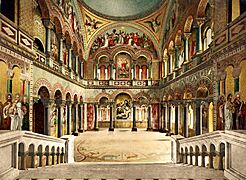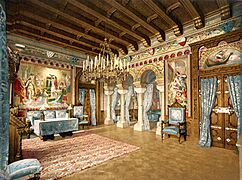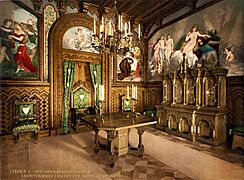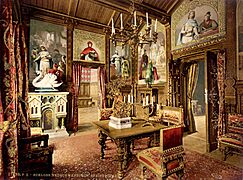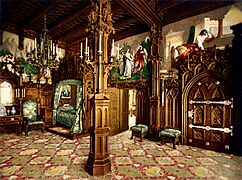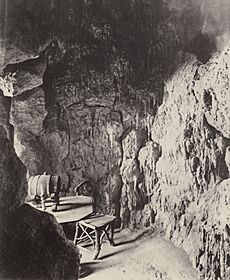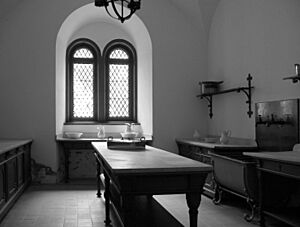Neuschwanstein Castle facts for kids
Quick facts for kids Neuschwanstein Castle |
|
|---|---|

Neuschwanstein Castle in 2013, looking northeast
|
|
| General information | |
| Architectural style | Romanesque Revival |
| Location | Hohenschwangau, Germany |
| Coordinates | 47°33′27″N 10°44′58″E / 47.55750°N 10.74944°E |
| Construction started | 5 September 1869 |
| Completed | c. 1886 (opened) |
| Owner | Bavarian Palace Department |
| Design and construction | |
| Architect | Eduard Riedel |
| Civil engineer | Eduard Riedel, Georg von Dollmann, Julius Hofmann |
| Other designers | Ludwig II, Christian Jank |
| UNESCO World Heritage Site | |
| Part of | The Palaces of King Ludwig II of Bavaria: Neuschwanstein, Linderhof, Schachen and Herrenchiemsee |
| Criteria | Cultural: iv |
| Inscription | 2025 (49th Session) |
| Area | 0.85 ha (2.1 acres) |
| Buffer zone | 2,114 ha (5,220 acres) |
Neuschwanstein Castle is a beautiful palace built in the 1800s. It sits on a rocky hill in the Alps mountains, in southern Germany, close to the border with Austria. You can find it in the Swabia region of Bavaria, near the village of Hohenschwangau. Another castle, Hohenschwangau Castle, is also nearby.
King Ludwig II of Bavaria loved the operas of Richard Wagner. He wanted a special, private place away from city life in Munich. So, he decided to build Neuschwanstein Castle. He paid for the castle himself, even borrowing a lot of money.
Construction started in 1869, but the castle was never fully finished. King Ludwig II wanted it as his own private home. However, he died in 1886, and the castle was opened to the public soon after. Since then, over 61 million people have visited Neuschwanstein Castle. More than 1.3 million people visit every year, with up to 6,000 visitors on busy summer days.
Contents
Where is Neuschwanstein Castle Located?
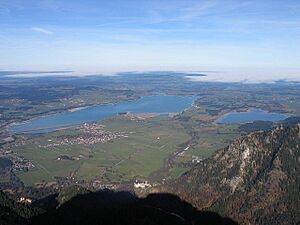
The village of Schwangau is about 800 meters (2,600 feet) above sea level in Bavaria, Germany. The area has mountains in the south and rolling hills in the north. Long ago, in the Middle Ages, three castles stood here. One was called Schwanstein Castle.
In 1832, King Ludwig II's father, King Maximilian II of Bavaria, bought the ruins of Schwanstein Castle. He built a comfortable new palace called Hohenschwangau Castle. This became his family's summer home. Young Ludwig spent much of his childhood there.
Two other castles, Vorderhohenschwangau and Hinterhohenschwangau, were on a rugged hill nearby. They overlooked the lakes Alpsee and Schwansee. By the 1800s, only ruins of these two medieval castles remained.
When Ludwig became king in 1864, he decided to build a new palace on the site of these two ruined castles. He called his new palace New Hohenschwangau Castle. After Ludwig's death, it was renamed Neuschwanstein.
How Neuschwanstein Castle Was Designed
Inspiration for the Castle's Look
Neuschwanstein Castle shows off a style called "castle Romanticism." It also reflects King Ludwig II's love for Richard Wagner's operas. In the 1800s, many old castles were rebuilt to look more beautiful and dramatic.
Ludwig was inspired by two trips he took in 1867. He visited the rebuilt Wartburg castle in Germany and the Château de Pierrefonds in France. Both castles were being transformed to look like medieval palaces.
Ludwig felt these buildings captured the romantic idea of the Middle Ages. They also reminded him of Wagner's operas, like Tannhäuser and Lohengrin. In 1868, Ludwig's grandfather died, giving him more money. This allowed Ludwig to start building his private retreat. He wanted a place where he could live out his dream of the Middle Ages.
He wrote to Richard Wagner in 1868, saying he wanted to rebuild the old castle ruins. He hoped to live there one day and create a "worthy temple" for his "divine friend" (Wagner). He also imagined scenes from Tannhäuser and Lohengrin in the castle.
Who Designed the Castle?
The castle's design was first sketched by a stage designer named Christian Jank. The architect Eduard Riedel then brought these ideas to life. The king was very involved in the design. He approved every single drawing himself. Because of his strong control, many see the palace as his own creation.
Neuschwanstein mixes different old styles like Romanesque (simple shapes), Gothic (tall towers and delicate details), and Byzantine art. It also used new technology from the 1800s. The castle's design often features themes from theater, as Christian Jank was a scenic painter.
Building Neuschwanstein Castle
Construction Process
In 1868, the old castle ruins were completely removed. The foundation stone for Neuschwanstein was laid on September 5, 1869. The cellar was finished in 1872, and the gatehouse was completed by 1882. King Ludwig II even stayed there to watch the building work.
The castle was built with bricks and then covered with different types of stone. White limestone came from a nearby quarry. Sandstone for windows came from a town called Schlaitdorf. Marble from near Salzburg was used for columns and other details. A steel frame was needed for the Throne Hall, which was added later to the plans.
Building materials were moved using scaffolding and steam cranes. For about 20 years, the construction site was the main employer in the area. In 1880, about 200 craftsmen worked there. Sometimes, up to 300 workers were active each day, even at night.
By 1884, the King moved into the main building, even though it was not yet finished. In 1885, he invited his mother, Marie of Prussia, to visit. By 1886, the outside of the main building was mostly done.
Neuschwanstein was not built for a large royal court. It only had rooms for the King and his servants. The palace was meant to be like a living theater set for King Ludwig II. It was also a "temple of friendship" dedicated to Richard Wagner, who died in 1883 without ever seeing the castle. King Ludwig II lived in the palace for only 172 days in total.
Castle Funding and Completion
The King's ideas for Neuschwanstein grew, and so did the costs. He paid for his building projects using his own money and income. He also borrowed a lot. The construction costs for Neuschwanstein during his lifetime were about 6.2 million German marks. This was almost double the first estimate.
King Ludwig II had other big building projects too, like Linderhof Palace and Herrenchiemsee. These projects used up all his money. By 1883, he owed 7 million marks. Even with huge debts, he wanted to keep building. He even threatened to harm himself if his creditors took his palaces.
In early 1886, his government refused to give him more money. In June, the Bavarian government decided to remove the King from power. He was forced to leave the palace. He died shortly after, on June 13.
When King Ludwig died, the castle was far from complete. Many parts were simplified or never built. For example, a huge tower planned for the main courtyard was never constructed. Plans for a castle garden were also abandoned.
Only about 15 rooms were finished inside the castle. The King never planned for the public to visit. However, just six weeks after his death, the palace was opened to paying visitors. The money from visitors helped pay off the construction debts by 1899. Neuschwanstein became a very important source of income for the Bavarian royal family.
When Bavaria became a republic in 1918, the state took over the palaces, including Neuschwanstein. It is now managed by the Bavarian Palace Department. Visitor numbers kept growing, reaching 200,000 by 1939.
Neuschwanstein During World War II
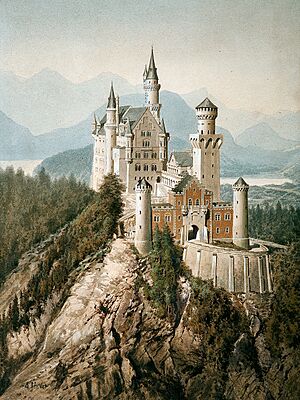
Because of its hidden location, the castle survived both World Wars without damage. During World War II, until 1944, it was used as a storage place for art stolen by the Nazis from France. The castle was used to organize these artworks. After the war, 39 photo albums were found there, showing how much art had been taken. These albums are now in the United States National Archives.

In April 1945, the SS thought about blowing up the palace to keep it and the artwork from falling into enemy hands. But this plan was not carried out. At the end of the war, the castle was given to the Allied forces without damage. Later, it was returned to the Bavarian government.
Castle Architecture and Design
Neuschwanstein Castle looks very artistic, both inside and out. King Ludwig's ideas are clear everywhere. For example, he gave specific instructions for a painting of Lohengrin in the main building. He wanted the ship further from shore and the swan's chain to be gold, not roses.
The main building has the Throne Room, King Ludwig's rooms, the Singers' Hall, and a Grotto. The design often honors German legends, especially those about Lohengrin, the Swan Knight. These stories were also important in Richard Wagner's operas. Many rooms have borders showing scenes from Wagner's operas.
Neuschwanstein Castle is made of several separate buildings spread out over 150 meters (490 feet) on a cliff. The long building has many towers, balconies, and sculptures. It looks like a romantic knight's castle. Unlike real castles that grew over centuries, Neuschwanstein was planned to look like this from the start. It has castle-like features but no real defenses, which were important for medieval castles.
Outside the Castle
You enter the castle complex through the Gatehouse. This building is unique because its outside walls are red brick, and the courtyard walls are yellow limestone. The top floor of the Gatehouse was King Ludwig II's first home at Neuschwanstein. From there, he could watch the construction.
The path through the Gatehouse leads into the courtyard. The courtyard has two levels. The lower part is next to the Gatehouse. The southern end is open, giving a view of the mountains. A planned chapel and a 90-meter (295-foot) tall tower were meant to be here but were never built.
Today, you can see the outline of the planned chapel on the upper courtyard pavement. The Rectangular Tower is 45 meters (148 feet) tall and offers great views. The Knights' House is on the north side of the upper courtyard. It was meant for the castle's male staff. The Bower, meant for ladies, is on the south side. These two buildings together look like the "Antwerp Castle" from the first act of Wagner's Lohengrin.
The main residential building, called the Palas, is at the western end of the courtyard. It is a huge five-story building with the King's private rooms. It has two stair towers, one of which is 65 meters (213 feet) tall. The western side of the Palas has a two-story balcony with views of the Alpsee lake. The entire Palas is decorated with many chimneys and colorful paintings.
Inside the Castle
If finished, the castle would have had over 200 rooms. But only about 15 rooms and halls were completed. The King's main rooms are on the upper floors of the Palas. The castle had some of the newest technology of the 1800s. This included a battery-powered bell system for servants and telephone lines. The kitchen even had an oven that automatically turned the cooking skewer. It also had running warm water and flushing toilets.
The largest room is the Hall of the Singers, followed by the Throne Hall. The Hall of the Singers is 27 by 10 meters (89 by 33 feet). It is on the fourth floor, above the King's rooms. It was one of the King's favorite parts of the castle. The room is decorated with themes from Lohengrin and Parzival. It was not used for big parties but as a monument to medieval knights and courtly love. The first concert here was in 1933, celebrating Richard Wagner.
The Throne Hall is 20 by 12 meters (66 by 39 feet) and is very tall, covering two floors. It was designed to look like a church. It has colorful arches and an area where the King's throne was meant to be, though it was never finished. The paintings show Jesus, the Twelve Apostles, and six saintly kings. The floor has a beautiful mosaic. The Throne Hall was meant to combine the Grail Hall from Parzival with the idea of a king's divine power.
- Palace rooms (late 19th-century photochrom prints)
King Ludwig II also had several smaller, private rooms. His living area is on the third floor of the Palas. It has eight main rooms and some smaller ones. The decoration often shows the King's favorite themes: the grail legend, the works of Wolfram von Eschenbach, and Richard Wagner's operas.
The drawing room has themes from the Lohengrin legend. Next to it is a small artificial grotto. This unusual room once had a waterfall and a rainbow machine. It connects to a small greenhouse. The grotto and the nearby study relate to Wagner's Tannhäuser.
The dining room is decorated with themes of courtly love. Since the kitchen is three floors below, a special lift was used to bring food up.
The bedroom and the small house chapel next to it are in a neo-Gothic style. The King's bedroom has a huge bed with detailed carvings. Fourteen carvers worked for over four years on the bed canopy. It was in this room that Ludwig was arrested on the night of June 11, 1886. The chapel is dedicated to Saint Louis, the King's namesake.
The servant rooms are in the basement. They are simply furnished with oak furniture. Servants were not allowed to use the main stairs.
Visiting Neuschwanstein Castle
Neuschwanstein welcomes almost 1.5 million visitors each year. This makes it one of Europe's most popular tourist spots. For safety, you can only visit the palace on a 35-minute guided tour. Photography is not allowed inside.
During busy times, from June to August, the castle can have up to 6,000 visitors a day. It's best to book tickets in advance. If you don't have a ticket, you can still walk up the mountain to see the castle from the outside and visit the courtyard. Tickets are sold only at the ticket center in Hohenschwangau. By 2008, over 60 million people had visited. In 2004, the castle earned €6.5 million.
Neuschwanstein in Culture and Science
Neuschwanstein is a worldwide symbol of the Romanticism era. The palace has appeared in several movies, including Ludwig II (1955) and Ludwig (1972), which are about the King. It was also seen in the musical Chitty Chitty Bang Bang (1968) and the comedy Spaceballs.
The castle inspired Disneyland's Sleeping Beauty Castle and Cameran Palace in the Pokémon movie Lucario and The Mystery of Mew (2005).
In 1977, Neuschwanstein Castle was featured on a West German postage stamp. In 2012, it appeared on a special €2 coin for Germany. In 2007, it was a finalist in the online vote for the New Seven Wonders of the World.
A meteorite that fell to Earth on April 6, 2002, near the Austrian border, was named Neuschwanstein after the palace. Three pieces were found. The meteorite is a rare type with a lot of pure iron.
On July 12, 2025, Neuschwanstein Castle was named a World Heritage Site by UNESCO. It was recognized along with Linderhof, Schachen, and Herrenchiemsee palaces.
Panoramas
See also
 In Spanish: Neuschwanstein para niños
In Spanish: Neuschwanstein para niños
- List of castles in Bavaria
- List of castles in Germany


